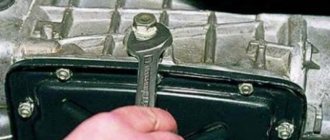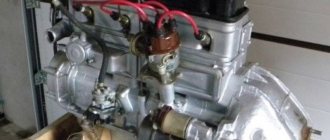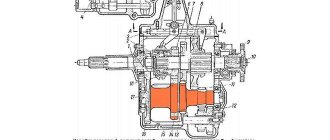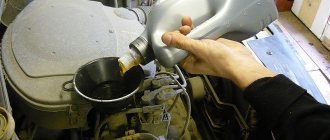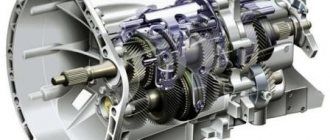Is it necessary to warm up the engine in your car in winter? The question arises with the arrival of cold temperatures. What is interesting about this issue is that opinions are divided into two diametrically opposed ones. Some car enthusiasts will certainly spend time warming up the power plant and only then start driving. And others will not pay the slightest attention to warming up - they will get into the car and start the trip.
So who is right after all? And is it necessary to warm up the car in winter before leaving, and how to do it correctly on different types of engines.
Why warm up the car?
There is such a thing as engine operating temperature. This is the temperature range at which the machine motor operates with maximum efficiency for a certain period of time. For installations running on gasoline, this optimal indicator is the range of 90-100 degrees (in some engines the temperature can reach 110 degrees). For diesel engines, the best option would be a temperature range of 85-90 degrees.
If the temperature drops below these indicators, additional wear of units and components occurs. And also the efficiency decreases, since the liquids servicing the systems do not function efficiently.
This is especially true for engine oil. Which has the necessary properties to service the motor precisely at optimal temperatures. When the car starts cold, the oil will need additional time. To take the desired consistency and begin to lubricate all components of the unit well.
With the oil frozen from low temperatures, the layer enveloping the parts will disappear. And the car will be forced to start with a dry start, which will greatly increase the degree of wear of the mechanisms. The correct choice of oil is also very important here - with thicker oil it will be more difficult for the engine to start working.
Similar problems will arise when starting up a heater that operates using coolant. Additionally, in this case, the engine can turn on speed to warm up, which increases gasoline consumption. Therefore, it becomes obvious whether it is necessary to warm up the car engine in winter.
Low temperature performance of engine oil
Let us make a short digression into the area of terminology in order to clearly understand the essence of the terms relating to low-temperature issues. So, there are temperatures:
- hardening, otherwise Pour Point. The temperature at which oil stops flowing and it cannot be poured from one container to another. For example, from a canister to an engine. This should not be confused with the “freezing” temperature. In petrochemistry, the term “freezing” refers to light petroleum products, such as diesel fuel; “solidification” applies to oils. Manufacturers often indicate some crazy Pour Point temperatures in their information sheets. There are also indicators of minus 54 °C. This does not mean at all that startup is still possible at this temperature. No and no again. The pour point is usually 5 degrees lower than the pumping temperature. For understanding, let me remind you that when the temperature decreases by 5 °C, the viscosity of the engine oil increases by about 2 times;
- pumpability limit. Essentially, this is the viscosity characteristic of oil at low temperatures and low shear rates of oil layers. Below this temperature, the oil pump simply will not be able to pump oil from the sump and push it through the oil lines, i.e. we will get dry friction and engine death. According to the SAE standard, the pumpability limit is the minimum temperature at which the viscosity of the engine oil is no higher than 60,000 MPas, ensuring pumpability through the oil system). The pumpability limit is, as a rule, 5 degrees above the pour point and 10 degrees below the turning limit;
- turning limit. It is tested on the “cold start simulator” CCS (Cold Cranking Simulator). It is 6200 MPa s for oils 0W-XX at a temperature of -35 °C; 6600 MPa s for 5W-XX oils at -30 °C; 7000 MPa s for 10W-XX oils at -25 °C. In fact, these values do not at all mean the minimum temperature at which it is possible to crank the crankshaft. Agree that you can grab the crankshaft even with spot welding, and after that with a starter with a power of 500 hp. check both the welding and the frozen oil. Therefore, the cranking temperature is a very conditional value, meaning that the starter is able to spin the crankshaft to starting speed, i.e., a successful start is achieved.
To warm up or not
The main rule, according to experienced car owners, is to wait until the engine speed drops to idle, after which you can begin a soft start. At the same time, you need to make sure that the revolutions do not go up: for diesel engines this figure is no more than 1500, for gasoline engines – no more than 2000 revolutions.
If your car is started in severe frosts (minus 20-30 degrees Celsius). The engine will still have to be slightly warmed up until the coolant temperature increases (50-60 degrees).
Warming up for too long will not be of much use - if there is no movement, you can only warm up the engine. And not in the most optimal way. The remaining components of the car (gearbox, axles, gearbox, dampers, as well as gaskets, tires, etc.) will still not be warmed up. It is possible to warm up these units only during soft driving at low speed, so wear on the units will be minimal.
These rules are suitable primarily for gasoline engines, since in severe frosts it is almost impossible to warm up a diesel engine. Autonomous heaters are designed for this, which operate from an additional energy source, such as a battery, mains, etc. The best option for warming up a diesel engine is to drive the car at low speed.
What prevents the engine from running with low oil temperature?
Let's try to understand what generally happens to the engine, its internals, and oil during low-temperature start-up. And in general, what is considered a low-temperature start? It is clear that when starting a conversation about oil, we mean the absolute serviceability of the battery, starter, ignition and fuel systems. We believe that the fuel is also appropriate for the season. Those. The startup itself should occur without problems. Let's consider two cold start cases:
- the temperature of the air, as well as the engine that has had time to cool down normally overnight, is equal to or lower than the so-called turning limit. OK! Somehow they were able to scroll - for example, carrying a car on a tie. But this does not mean that everything is in order: if the oil temperature is still five degrees lower than indicated (line above), then we run into the so-called. pumpability limit, i.e. The oil viscosity reaches 60,000 MPas. This means that the oil cannot be pumped by the oil pump through the oil channels to the crankshaft bearings, into the timing mechanism, and will not get onto the cylinder walls and pistons. Those. the engine will simply die. I won’t even consider this situation - the drivers from the Yakut mines, or Uncle Sasha from MTS, will probably tell you what to do in this situation - a blowtorch under the pan, “pouring” the engine with boiling water, or not turning it off at all for days... Wow!
- the second case (ours), i.e. when the temperature of the oil (read - engine or outside air) on a cold winter morning is higher than the cranking temperature. It is clear that the situation is the most common, because everyone who lives in regions with cold winters prepares for these winters and uses oils (by their own decision or the advice of older comrades) that can ensure starting at the lowest temperatures that can only happen in their hometown. It is believed that reliable starting can be ensured with an oil viscosity of less than 6500...7000 cSt. This is where disagreements arise - is it possible (or necessary) to start moving immediately after launch? Or is it necessary to warm up for a long time to operating (or some other) temperature?
So what happens to the engine and oil during a cold start? Why is a cold start dangerous for an engine?
- Longer filling time for engine oil lines. Briefly, the point is: if we take the power of the “battery + starter” pair at a temperature of +20 °C as 100%, then at a temperature of -30 °C it will be only 20%. Those. the starter will rotate the crankshaft much more slowly; starting, taking into account the reluctance of gasoline to burn at such temperatures, will occur later. And all this time, the barely rotating oil pump will work with low performance, which will lead to a slow increase in pressure in the oil system. And the pressure is so necessary! From the point of view of hydraulics, friction pairs (for example, a connecting rod or main bearing) can be considered as a jet, a flow section. It is known that the flow rate (read – throughput) through the flow section is directly proportional to the cross-sectional area, the pressure difference “before-after” and inversely proportional to the viscosity of the liquid. Well, the cross-sectional area does not change with temperature, but low pressure in the oil system (we are talking specifically about the first seconds of operation, when the starter barely turns the crankshaft) plus thick oil will lead to the fact that much less oil will pass through the liner than this necessary. The result may be rupture of the oil film and dry friction, i.e. scuffs on the crankshaft. In the M278 engines, the plant did something more interesting - it installed a shut-off valve on the oil supply line to the piston crown cooling nozzles, which shuts off the supply at low engine temperatures. Two “birds with one stone” are killed - the extra oil consumer is switched off, and the pistons warm up faster. The downside is that the extra heat source was removed to warm up the oil faster.
- Then the oil begins to heat up, and it heats up more intensely the more viscous the oil. Relatively speaking, when using 10W-40 the oil itself will warm up faster than using 0W-40. But here we are faced with another feature of Mercedes engines: with rare exceptions, they are all equipped with water-oil heat exchangers. This heat exchanger is an additional point where the oil loses the heat we need so much, giving it away much more slowly to the warming up coolant. Therefore, on machines with such a heat exchanger, the oil heats up much more slowly.
Water-oil heat exchanger using the example of the M272 engine
So, the more viscous the oil is used in the engine, the faster the oil heats up: the more viscous the oil also causes high friction in the pairs. One thing to note is the influence of the presence of fuel in the oil. Very often you hear stories that with 10W-40 or even 15W-40 oil the engine starts well at temperatures of minus 30 and below. Owners of these cars have reason to think:
- if 500 ml of gasoline gets into 5.5 liters of engine oil of an M271 engine, then the viscosity of the oil at a temperature of 40 °C will be only 43% of the viscosity of pure oil;
if 350 ml of gasoline gets into 5.5 liters of engine oil of an M271 engine, then the viscosity of the oil at a temperature of 40 °C will be only 50% of the viscosity of pure oil;
- if 190 ml of gasoline gets into 5.5 liters of engine oil of an M271 engine, then the viscosity of the oil at a temperature of 40 °C will be only 63% of the viscosity of pure oil;
- if 100 ml of gasoline gets into 5.5 liters of engine oil of an M271 engine, then the viscosity of the oil at a temperature of 40 °C will be only 78% of the viscosity of pure oil;
- if 44 ml of gasoline gets into 5.5 liters of engine oil of an M271 engine, then the viscosity of the oil at a temperature of 40 °C will be only 87% of the viscosity of pure oil;
- The gaps in the engine pairs and joints are far from the calculated ones. Let’s say, for a “piston-liner” pair, the gap increases twice as much as the nominal one (specified for the assembly process, i.e. at a temperature of +20 °C). You yourself understand that calculated, i.e. at operating temperature, the gaps are even smaller. But in the “piston pin – piston” pair, on the contrary, the gap tends to zero, i.e. it's about "snack". Everyone has noticed in one way or another that after a low-temperature start, the engine runs much noisier. This is the result of working with off-design clearances, which ultimately leads to excessive engine wear. It is believed that one warm-up from minus 30 to operating temperature takes about 500 km from the engine life. Therefore, the task is to warm up the engine as quickly as possible, minimizing wear.
Moreover, 10% of the fuel that gets into the engine oil will not turn into zero after 24 hours of engine operation, but only into 0.7...1%. Those. fuel evaporates extremely difficult.
Surely there will be someone who will say that such an amount of fuel cannot get into the oil. I refer you to the result of an analysis of oil from an M156 engine with a mileage of only 9000 km after the Moscow winter. Read here. Please note - the car is most likely absolutely in good condition in terms of the battery, ignition system, most likely the owner does not save on fuel (fills up with something premium), and so on. And yet, the oil contained 1.2% gasoline.
As for the M271 engines specifically, I didn’t just mention it here for the sake of saying it. Many people remember last winter, when thousands of owners of brand new Tseshek and Eshek with a 271.8 engine stupidly wandered around the services, trying to understand why they had 2 (two) oil levels in their engine?
How to properly warm up a car in winter
There are several common options for warming up the engine. In order to determine the difference in atmospheric emissions, experts carried out an experimental test. The initial data for this test were identical for all options: the same car was used as a basis, the same temperature indicators - minus 15 degrees Celsius, a fully charged battery, premium synthetic oil and 5 km of range from the parking lot.
Warm-up options for the experiment:
- Completely warm up the engine at the parking spot (about 20 minutes). After the start, gasoline consumption became 2.5 l/h; after 10 minutes, this figure dropped to 0.9 l/h. The coolant temperature after warming up was less than 50 C. When starting to drive, gasoline consumption was 6.5 l/100 km. A total of 0.73 liters was consumed: 0.4 for warming up and 0.33 liters for the ride itself.
- Warming up when the car is moving. When the engine was started, the car immediately drove: consumption jumped to 10 liters, then dropped to 6.8 liters. A total of 0.45 liters was spent and the warm-up time without moving was saved, as in the first option (about 20 minutes).
- Minimum warm-up in the parking lot before driving for 5 minutes. At the initial stages, the consumption was 7.6 l/100 km, by the end of the ride it was 0.55 l. But this indicator turned out to be higher than in the second option.
However, if we talk about emissions, the third option turned out to be the most effective, where the emission level was no higher than 2.1, and then slightly exceeded 1 gram CH, which meets European standards. In the first option, this level was 180 ppm, and in the second warm-up option – 20 ppm. Therefore, experts recommend minimal warming up when moving further.
Is it necessary to warm up the car in winter?
As you might have guessed, I will answer yes to this question. Warming up your car in winter is more important than ever. I definitely recommend warming up the engine in winter before driving, and here's why:
- In cold weather, even “fifth” synthetic oil resembles paraffin, and in extreme cold, even “nulevka” looks like frozen snot. Consequently, you can forget about the correct performance characteristics of the lubricant. This means that starting the power unit under such conditions greatly reduces the life of all parts rubbing against each other. You should not add to this the operation of a cold engine under load.
- Warming up the car in winter helps to achieve optimal or almost optimal operating temperatures for all operating fluids. And this is important - we are interested in preserving the resource not only of the engine, but of all components and assemblies of the vehicle.
I hope that the question of whether it is necessary to warm up the engine in winter or not is no longer necessary. Now let's talk about at what temperature warming up is needed, how often in winter the car needs to be warmed up, is it necessary to warm up the car at night, is it necessary to start the car without further operation if there is no trip.
Well, at what temperature you should warm it up, and at what temperature you don’t have to “bother”, I think it’s clear. We warm it up in any weather. I have already written enough about this. But there’s another question, how often should you warm up the car? I think it’s important enough to answer in more detail.
Many people are interested in how often they need to warm up their car in severe frosts, and, as a result, whether it needs to be done at night. As has already been said (yes, this is, in principle, a well-known fact), starting an engine at subzero temperatures causes significant damage to rubbing parts. Therefore, I think you will agree with me that there is no point in starting a car if you do not plan to drive it later. But this statement is true only if the temperature of the power unit corresponds to the ambient temperature.
If you want to prevent the oil from freezing and, thereby, extend the life of the engine, then a completely logical solution would be to warm up the “engine” from time to time. In this case, the car should be started until the engine has cooled down (the oil temperature must correspond to the operating parameters). It is quite possible that you will have to set it to “automobile factory” so that the car warms up even at night.
If the car has been sitting idle for a week, for example, then there is no need to warm it up unless you need to drive it later. As already mentioned, this will only reduce engine life.
I hope you got the answer to the question, is it necessary to warm up the engine, and how often should you warm up the car in winter? If yes, then I consider my mission accomplished




